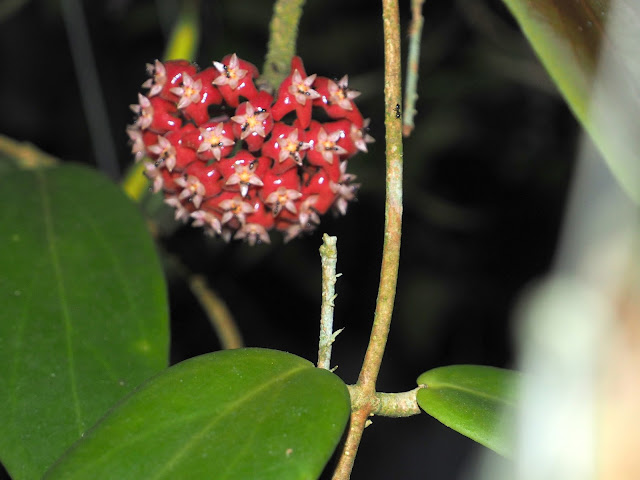In my province where my garden is, it only gets colder at dawn, so we feel the most out of it as much as we can. At noon we still get 32-35°C. What do you say about our temps, when some countries already have the negative numbers? That is fine, as long as we still get enough flowers. They are dwindling now, but they don't really get lost, they just mature and produce seeds. Some are still blooming though.
There are 2 orchids there, the terete Vanda and the white Dendrobium.They are self supporting so not very luxurious in growth.
This Ixora coccinea just blooms continuously throughout the year. It doesn't mind if its raining or dry season. During the latter the leaves just get yellowish but still produce flowers. And can you see that Scarlet Mormon butterfly? It is one of our biggest, and also one of the most difficult to photograph.
The red hibiscus is always there too, we just always prune it to get just bushy. Red against green is very Christmassy in color.
This firespike is under the trees, yet continuously produce those red spikes.
Yellow heliconias are blooming too, but the blooms are few compared to the leaves, so i can't get a wide angle shot with lots of them.
Gardenia when in bloom gives sweet fragrance in the vicinity. It is just unfortunate that the bloom stays open only for a day.
Turnera subulata is tolerant of the dry season.
Turnera ulmifolia also has deep roots that allow it to thrive even during the dry season. Dry or wet, the turneras are always around. It is much loved by the honeybees and stingless bees.
my white dendrobium
another self supporting terete Vanda perfectly lovely in lavender
Asystasia intrusa
Asystasia intrusa lives up to its name, very invasive! If we will not cut their vines, it will conauer every space in the property. Here it serves as fence climbing the cyclone wire.
Pentas lanceolata, another favorite of the butterflies, stressed during the dry season though.
Hoya buotii, named after one of the botanists at the University of the Philippines Los Banos.
Hoya nakarensis, named from the place it was first collected, Nakar, Quezon.
Hoya alwitriana, very much loved by the native honeybees. Even if there are hoya blooms around, they just converge in this hoya. Yellow is attractive to insects.
Hoya ilagiorum is also named after a family from UP Los Baños, it flowers all year when propery attended to.
And of course, this Hoya diversifolia is constantly blooming from September to January. Most of you have seen this, as i can't resist posting them blooming at the top of the lanzones trees. It suffered a bit when we cut some branches of the tree for the new hoya house. I gave some friends a lot of cuttings. I hope the remaining vines will continue flourishing for many years.






















